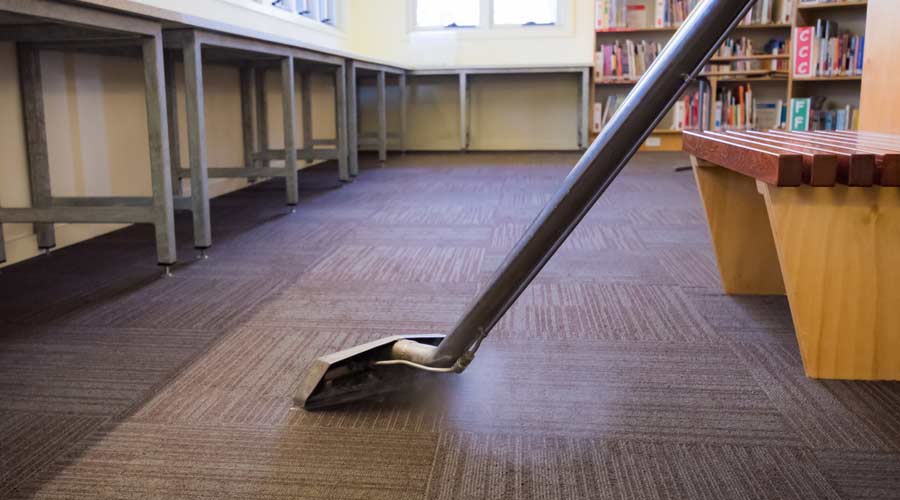
When it comes to sustainability, it’s not all about using green certified chemicals and equipment.
The mission statement for the Custodial Services Department at the University of California, Riverside, is to provide the campus community with a healthy, safe and clean environment in which to work and learn. The team is also committed to executing a sustainable cleaning program that uses environmentally preferable products, equipment and work methods that effectively clean and maintain over 3 million square feet of building space with 99 custodians daily.
Over the last seven years, the department has worked hard to reduce the number of toxic chemicals used in the program to a point where they now use green-certified products and equipment in over 90 percent of cases. They have also increased the use of automated and ergonomic equipment, which has improved the quality of service and helped reduce injuries.
Having reached these remarkable milestones prior to the COVID-19 pandemic, the team recently started shifting their focus to improving their work methods and practices.
Sustainable cleaning doesn’t just mean using certified chemicals and equipment that meet environmentally friendly criteria. It also includes the implementation of safe, effective and efficient work methods that will protect the health and safety of your staff; a cleaning operation’s most precious resource.
Effective Staffing
During the COVID-19 pandemic, the university was at about 30-50 percent occupancy for approximately 18 months. The limited number of faculty, students and staff on campus allowed the department to conduct a deep analysis of their buildings.
Custodial supervisors walked through each room of every building, taking inventory of the area, the type of flooring and its square footage. This process allowed them to have a better understanding of the necessary staffing and equipment needed to properly maintain their buildings. These evaluations resulted in the creation of custodial work assignments that outline not only the spaces that need to be cleaned, but the time needed to clean them.
Effective Cleaning Procedures
Once the space was evaluated and cleaning needs were outlined, effective cleaning procedures were created. This was necessary so that custodial staff would have a clear understanding and a guide that lists the cleaning tasks and frequencies required for each area.
For example, restrooms have a total of 14 cleaning tasks associated with the space. This guide acts a checklist, but also as a training tool to ensure that custodians are consistently doing their work specific to operational standards across all buildings.
Measuring Quality
There is a popular saying, “You can’t manage what you can’t measure.” It was essential that once the program was created, the team outline a process to measure successes and failures.
A quality control process was developed whereby custodial supervisors are responsible for completing 10 inspections a week by using a cloud-based software program on their mobile phone. This technology allows them to track quality of service throughout the campus. A successful quality control program also allows for greater engagement between the supervisors and staff, provides immediate feedback, resolves challenges through coaching and retraining, and provides staff with recognition for outstanding work.
Day Porter Program
Historically and in many facilities, cleaning is done in the evenings when occupants are out of the buildings. On this campus, the team developed an approach to providing custodial support during the day, when most of the campus community is onsite.
Prior to the pandemic, the department did not have daytime custodians dedicated to maintaining the appearance of building entrances, responding to emergencies, restocking heavily used restrooms, and policing other public spaces throughout the day. The new approach of adding a day porter answered this need. This also relieved pressure from the custodians assigned to clean these areas after-hours, since there was now additional cleaning being done before their shift.
Department Website
In order to create transparency between the custodial department and campus stakeholders, a website was created to outline the cleaning and disinfecting process and provide responses to frequently asked questions (FAQs) regarding the services that are provided. This includes information about how often areas in each building are cleaned, the definition of high-touch cleaning and insight into the types of products that are used to disinfect particular surfaces. The website also provides cleaning schedules where building occupants can view the service days for each area of a building.
Moving Forward
With a solid plan in place, the department will continue to focus on overcoming staffing shortages by recruiting custodial staff, a problem that has plagued the cleaning industry since the pandemic. They will also continue to develop their program through the use of autonomous floor equipment, on-site generation of cleaning chemicals and working to obtain an industry certification that furthers their goal of cleaning for health.
Aaron Uresti is the Assistant Director of Custodial Services & Resource Management, Facilities Services Department, at the University of California, Riverside. He holds a LEED Green Associate Credential and currently serves as a Steering Committee Member with Healthy Green Schools and Colleges.

 The Down and Dirty on Cleaning in Virus Season
The Down and Dirty on Cleaning in Virus Season How Surfactant Use is Expanding in Commercial Cleaning
How Surfactant Use is Expanding in Commercial Cleaning Operational Excellence Series 2025: Better Budgeting
Operational Excellence Series 2025: Better Budgeting